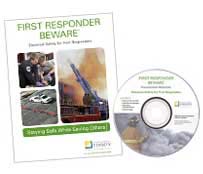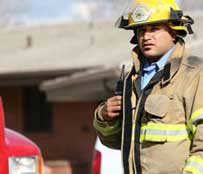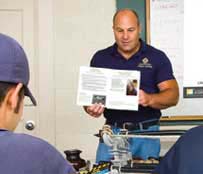
Order Free Materials
Provide vital information that every first responder must know to stay safe around utility lines.

Advanced Safety Info
Firefighters, police, and EMTs are typically first on the scene in an emergency and face the greatest risk from electrical contacts and fires. Understanding the potential dangers and learning how to deal with them correctly makes everyone safer.

Interactive Presentation Tools
Our interactive presentation tools give you everything you need to teach and learn about working more safely in emergencies involving electrical utility lines. You can use them on this website, or download them by right-clicking an item and saving it to your computer.
Order Free Safety Presentation Materials
To help you teach First Responders how to work safely around electrical utility equipment, we're pleased to offer you a FREE safety presentation kit.
How to Order: Simply click the "Order" button below and complete the online order form. Orders are filled on a first-come, first-served basis. Please allow 2 to 4 weeks for delivery.
Order Materials >
Advanced Safety Information
Assume all lines are energized and potentially dangerous.
Keep personnel and equipment at least 10 feet from overhead lines at all times. Consider how close aerial equipment will be when fully extended, and use a spotter to monitor placement.
OSHA requires greater than 10 feet of clearance from lines that are over 50,000 volts. For example, the minimum clearance for a 500,000-volt line is 18 feet. There are no visible markers to identify a power line’s voltage, so call the local electric utility for clearance information if you are unsure.
Ladder Hits Lines; Firefighter Dies
Three firefighters were positioning a 35-foot aluminum extension ladder outside a three-story building with an active fire on the third floor. Two of the firefighters apparently slipped and lost control of the ladder, which fell against a 7,600-volt power line. One firefighter was killed and one was seriously injured.
Secure the area. Keep yourself and the public at least 100 feet away from fallen power lines. Fallen transmission lines from large towers require 100 feet of clearance.
Stay clear of all downed lines and anything they are contacting, including nearby fences, trees, cable or phone lines, and the ground.
Be extremely cautious when using water to fight fires near downed power lines. If you must use water, use only a mist or spray. Do not use a stream—it can create a clear path for current.
Fire Captain Electrocuted by Downed Line
A 36-year-old fire captain was fatally shocked when he brushed against a fallen 12,000-volt power line while fighting a predawn house fire. The line had fallen into a nearby pine tree and was dangling just above the ground.
Do not enter or contact vehicles that may be energized. Instead, instruct victims to drive the vehicle away from the line if they can do so safely.
If the vehicle cannot be safely moved, instruct victims to stay put until utility personnel give the all clear.
If victims are in imminent danger from fire or other hazards, stay away, and instruct them to jump clear without touching the vehicle and the ground at the same time. They must land with their feet together and shuffle away with small steps.
If victims are injured, disabled, or otherwise unable to safely exit the vehicle, your incident commander will tell you how to proceed.
Vehicle Rescue Goes Awry
A car that had struck a utility pole laid on its side with an injured passenger pinned inside, just two feet away from downed power lines. In an attempt to stabilize the vehicle, rescuers ran a steel winch cable below the sagging power lines and attached it to the car’s luggage rack. A fire chief, a firefighter, an EMT, and a bystander were holding the cable when the luggage rack pulled loose; it and the cable contacted the energized lines. The fire chief and bystander were both killed; the firefighter and EMT were severely burned.
Let it burn. Burning electrical equipment is already ruined and will be replaced. Contact the local utility and wait for them to arrive.
Evacuate the area. Keep people at least 300 feet away. Protect exposures to prevent fire from spreading.
If an equipment fire must be suppressed, utility personnel and your incident commander will tell you how to proceed.
Successful Response to Substation Fire
A circuit breaker containing 20 gallons of mineral oil caught fire and exploded at a rural electric substation. Flames and smoke shot 200 feet into the air. Firefighters evacuated nearby residences within 300 feet, set up a 100-foot perimeter around the substation, closed the nearby highway, and let the fire run its course. Thanks to proper response procedures, no one was injured.
Interactive Presentation Tools
Our interactive presentation tools give you everything you need to teach and learn about working more safely in emergencies involving electrical utility lines. You can use them on this website, or download them by right-clicking an item and saving it to your computer.
- Safety Presentation Guide. Step-by-step instructions for an easy, effective safety meeting.
- Slide Show. A 15-minute presentation of critical safety tips.
- Slide Show Presenter’s Notes. Talking points to support use of the slide show in a safety presentation.
The First Responder Beware safety slide show can be used for individualized or group instruction. If you plan to present it in a group presentation situation, you may find the presenter's notes useful. These notes provide slide-by-slide talking points and additional information.
